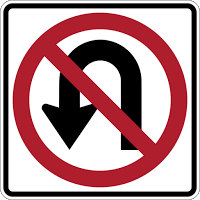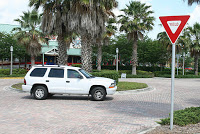Tag Archive: traffic safety

Making a Safe U-Turn
January 30, 2012
Intersection crashes cause the most number of fatalities more than any other crash location. Not only are they spots where red light runners might cause dangers, but also consider the fact that drivers making an innocent U-turn usually become involved if there ever was a crash.
What is truly important is: before making a U-Turn, make sure that you are aware of your state’s laws. Some states allow U-Turns at any intersection, unless there is a traffic sign that states: “No U-Turn Allowed”. There are other states that only allow for U-Turns when there is a “U-Turn Permitted” traffic sign. Almost all states do not allow U-Turns over double yellow lines painted on the road.
You may only make a U-Turn when the traffic light facing you is either a green arrow permitting a U-Turn, or a solid green light. Many people incorrectly assume that they can make a U-Turn while the light is red, even if their vehicle was a considerable distance from the center of the intersection. This is a violation, because doing so is still running a red light.
Here are some rules to making a safe U-Turn:
- Plan your U-Turn by looking for pedestrians or individuals riding bicycles. This means checking if you might hit someone or something when turning into the opposite direction.
- Always look in both directions before beginning your turn. If the light facing you has turned green, wait a second or two for possible red light runners coming from the opposite direction. This is the one tip that might save you the hassle of a crash.
- It’s a good idea to take your foot off the accelerator and moving it closer to the brake, should you need to stop, or when an emergency situation arises.
- If you have started your turn and the light changes, complete your turn as soon as traffic clears. Never try to back up in an effort to avoid blocking the intersection.
- It is important to note that you should always be making your U-Turn while you are at the left portion of the lane closest to the center line of the road. You are not allowed to make a U-Turn near the crest of a hill, a curve, or any other place where other drivers cannot see you from at least 500 feet away from the same direction.
U-Turns are the best way to get back to a location you missed, and making sure you know the right safety precautions while taking them assures you that you get there faster, and safer.

10 Most Confusing Traffic Signs
December 27, 2011
We all know that traffic signs do an important job: they tell us what exactly we can or can’t do on the road. But what if the signs were confusing? Sometimes this leads to funny stories afterwards, other times it leads to tragedy, as a misunderstood sign may sometimes lead to crashes.
These signs, wherever state they may show up, must be approved by the Manual on Uniform Traffic Control Devices (MUTCD). They create the standard by which all signs could be installed, maintained, and managed by road managers everywhere. The MUTCD is published by the Federal Highway Administration (FHWA).
Here then, is a list of some of the more … confusing traffic signs that are currently out there.
Yield – The red upside-down triangle sign, or sometimes, a simple verbal instruction to “YIELD”? It’s surprising just how many people get confused with this sign. The best way to describe it is it’s like a lighter version of the STOP sign. When faced with this sign, motorists should stop, give way to vehicles from another approach and then enter an intersection. These usually appear in smaller roads that don’t get enough traffic that they don’t necessarily need a STOP sign.
Runaway Vehicles Only – But what if you weren’t running away? This sign signifies that a runaway device is installed in an area. This is usually for trucks that have lost control — the device is usually a patch of road with sand or gravel, which helps vehicles come to a safe stop. The gravel or sand allows the momentum of the big vehicle to dissipate, allowing for safe stopping.
This Side of Sign – This sign signifies that something is allowed on “this side” or the side where the sign is installed. A variation of this sign may say “Parking This Side of Street.” This means that one may only park on that specific side and parking elsewhere may give you a parking ticket.
To Request Green Wait On [Bicycle symbol] – Blame it on confusing wording. This sign is supposed to give bikers a green light. This sign should be used in conjunction with traffic actuators that are adjusted to the amount of metal a bicycle has. If you’ll notice, there is a vertical line going on the top and bottom of the bicycle symbol. This means that bikers should position themselves in the designated marking for them to be detected by the actuators, giving them a green light. Some people confuse this as waiting for bicycles to ride by until they can get a green light.
Look <—-> – Looking left-to-right? Isn’t that what parents and preschool teachers teach kids before crossing the road? This sign is usually located near railways, signifying that motorists should be on the lookout for trains from both directions.
Truck Rollover – Nope this sign doesn’t signify the truck-wheelie lane — it only means that there is a slope nearby that truck drivers should be aware of, since there’s a big tendency for their vehicles to rollover.
Circular Intersection – Though it bears a striking resemblance to the recycling sign, this sign simply signifies that a circular intersection is coming up. Some circular intersections are different. In some cases, the entering vehicles have the right-of-way, while the vehicles inside the circle must yield. Sometimes this is reversed, so drivers have to do a bit of research before they go right through.
Stop Ahead – Stop vertically? No — this is simply a sign that signifies that there will be an oncoming stop. A sign for a sign, perhaps?
9% Grade – The roads aren’t trying to quantify your reading level or your abilities with math. This only means that there is an oncoming 9% Grade slope. Slopes on the road are measured in grades: consider that 9% is 9-feet off a hundred. It means that elevation may change from 5 (5% Grade) to 9 (9% Grade) feet.
DIP – Motorists have to wonder: how exactly are they going to “dip” their cars? This simple sign that says “DIP” means that there will be a dip in the road: parts of the road may go down, and then elevate right back up again.
Having trouble with learning the Roads of the Road and Traffic Signs? Take a DMV Practice Test to become an expert and pass your DMV written exam the first time.

Driver Education: Traffic Safety for New High School Graduates
June 5, 2009
Summer is here and school is out. Many young drivers will be spending more time on the road going to the beach or pool, working at summer jobs, and having fun with friends. This is an especially exciting time for teens who are 2009 high school graduates. Recent grads are filled with elation, a sense of freedom, and hopes and dreams for the future. But euphoria and increased independence can cause problems when they lead relatively inexperienced drivers to take chances behind the wheel. And summertime is a dangerous time for drivers in general; traffic deaths for all drivers increase during the warm-weather months, peaking in July.
Three deadly holidays take place during the summer – Memorial Day, the Fourth of July, and Labor Day. According to the National Center for Statistics and Analysis, in a 2004 analysis of six holiday periods, the average number of traffic deaths during holiday periods was 156 per day, compared to 117 per day on non-holidays. According to the National Highway Traffic Safety Administration, 20 of the 25 deadliest days on US roads over a five-year time frame fell during the period from Memorial Day weekend to Labor Day.
Teen motor vehicle fatalities are also highest in the summer, partly because it’s an unsafe time for all drivers, but also due to risk factors specific to young drivers. Like other drivers, teens spend more time on the road during the summer (averaging 44% more hours driving each week, according to the NHTSA) and are more likely to drive at night. But they lack the experience of older drivers in dealing with heavy traffic and low-visibility conditions. Like other drivers, teens behind the wheel in the summer are often accompanied by multiple passengers. But teens are often much more distracted by their passengers than older drivers, and they are unlikely to assert themselves even when they are aware that they need to concentrate on driving.
Parents who want their teens to survive the summer must stay involved in their teens’ driving activities. Without close supervision, the vast majority of teens lack the emotional maturity to stay safe behind the wheel – or as passengers of other teen drivers.
-Though most parents will broaden driving privileges for summer, avoid giving teens too many privileges at once. Extend privileges one at a time and make sure teens prove they can handle the increased responsibility before adding more.
-Conduct supplementary driver training lessons. For example, many teens have limited experience with night driving during the school year; a few lessons will help them learn good nighttime driving habits from the beginning. A teen driving checklist helps parents provide valuable feedback on the driving lesson.
-A driver training course will help teens review fundamental driving concepts during a time when they are most at risk. A quick safe-driving refresher could help an inexperienced young driver make the right choice in an emergency. Parents whose teens receive even one traffic ticket must address the issue immediately; tickets mean teens are probably engaging in more risky driving behaviors than parents realize.
-Parents should check up on their teens’ seat belt use as often as possible. In 2006, the NHTSA reported that 58% of 16- to 20-year olds who were involved in fatal motor vehicle collisions were not wearing seat belts. The Insurance Institute for Highway Safety reports that teen seat belt use increases over time when strict parental limits are set.
-A heightened level of awareness about their teens’ access to alcohol, particularly on holidays, is critical for concerned parents. Teens may even have access to alcohol via their friends’ parents; ensure that teens understand that underage drinking is never acceptable, no matter what any other parent says or does, even for a special occasion. Create a codeword so your teen can ask to be picked up without risking the ridicule of friends.
